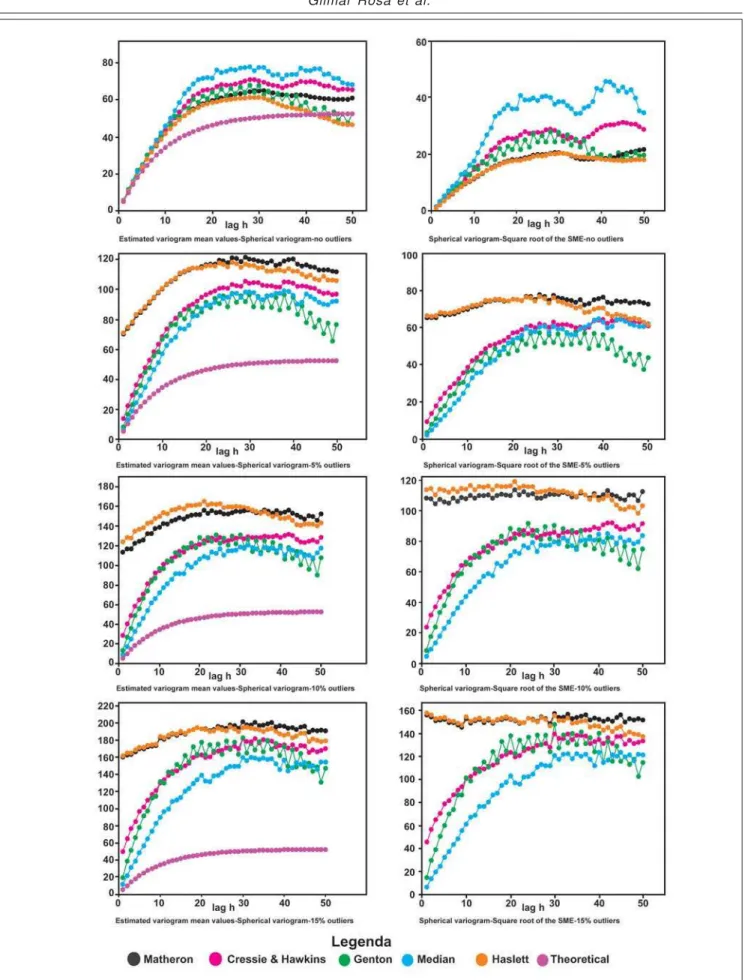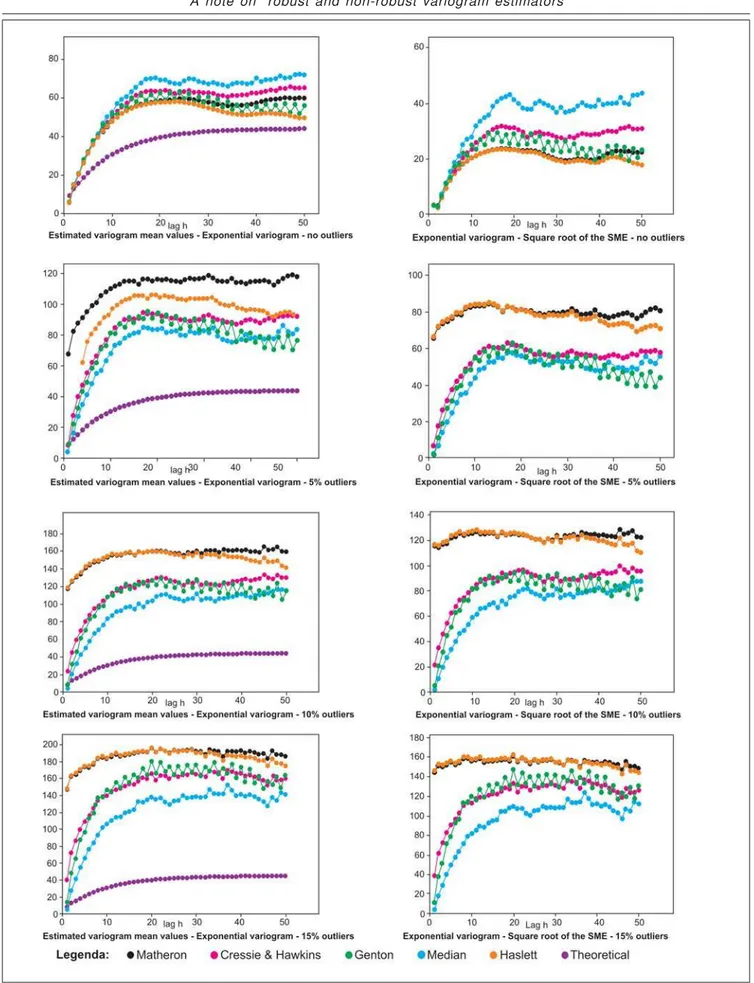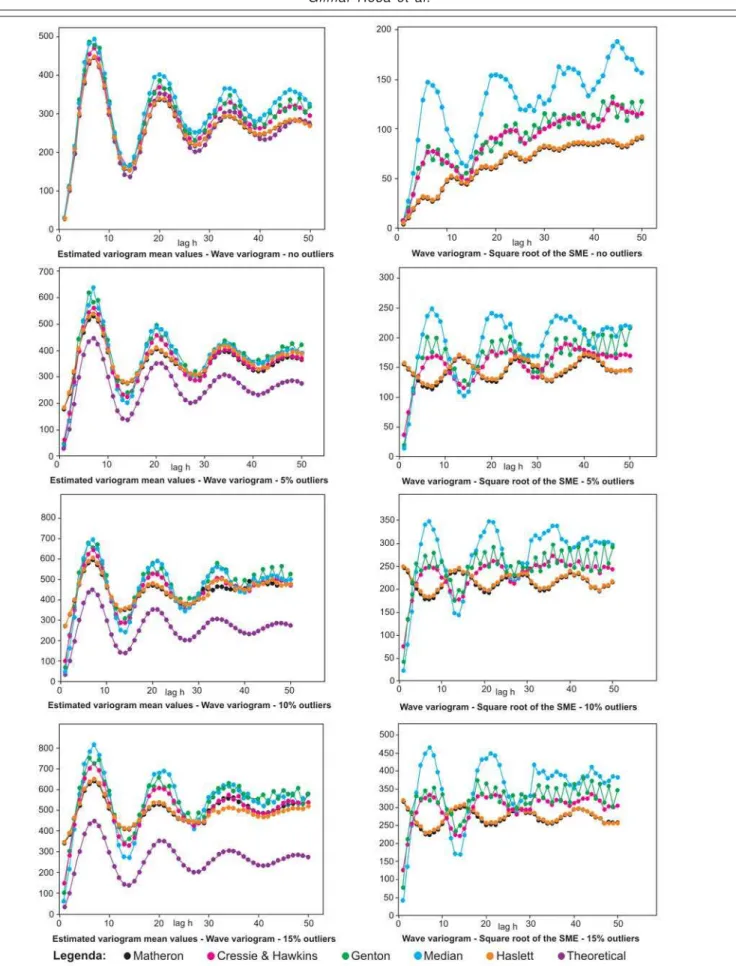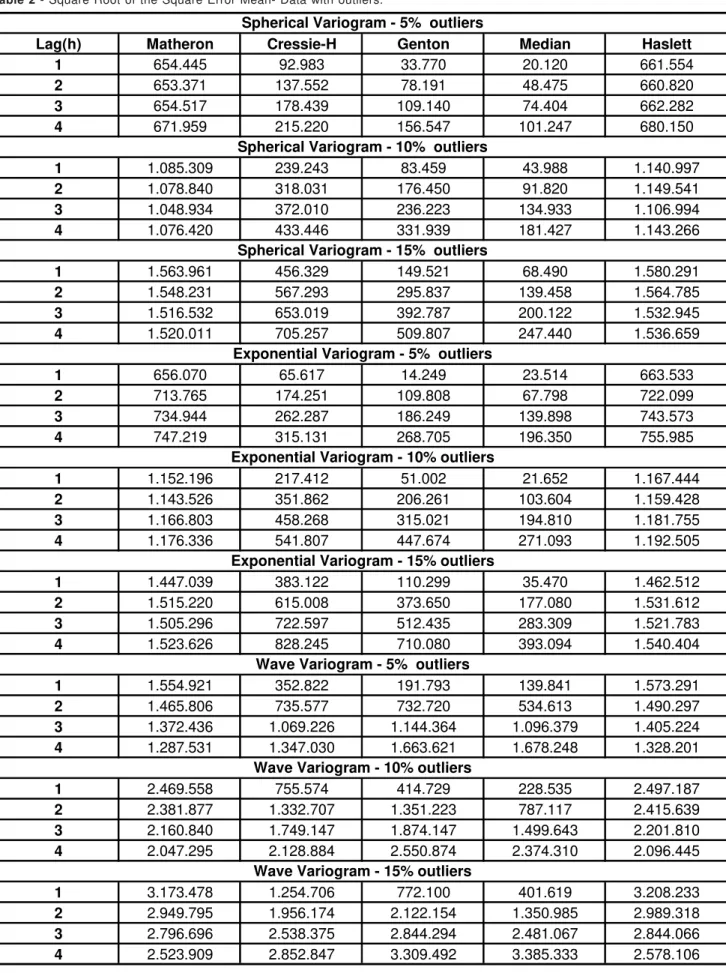Abstract
In 1998 Genton proposed a variogram estimator claimed to be robust against outliers and compared it to Matheron’s and Cressie-Hawkins’ variogram estimators. Lark (2000) extended the comparison evaluating the effects of nonnormality. However, the comparison was limited to the spherical variogram model. In this paper 4 variogram estimators are compared including Genton’s by using Monte Carlo simulation. Data with and without outliers were simulated using the spherical, exponential and wave models. The results showed that Genton’s and the Median estimators were the best choices for contaminated data, while those of Matheron and Haslett presented better results for non-contaminated date; this latter being appropriate only for time series analysis.
Keywords: Spatial statistics, robust and non-robust variogram estimators, outliers.
Geociências
A note on robust and non-robust
variogram estimators
(Uma discussão sobre os estimadores robustos e
não-robustos de variogramas)
Sueli Aparecida Mingoti
Ph.D em Estatística. Professora Associada do Departamento de Estatística da Universidade Federal de Minas Gerais-UFMG, Belo Horizonte, Minas Gerais E-mail: sueliam@est.ufmg.br
Gilmar Rosa
Mestre em Estatística. Doutorando em Computação Aplicada Instituto Nacional de Pesquisas Espaciais - INPE, São José dos Campos, São Paulo E-mail: Gilmar@dpi.inpe.br
Resumo
Em 1998, Genton propôs, um estimador de variograma que seria robusto em relação à presença de valores discrepantes (outliers) e o comparou com os estimadores propostos por Matheron e Cressie-Hawkins. Lark (2000) estendeu os resultados, avaliando o desempenho dos estimadores na presença de não-normalidade. Entretanto, ambos os trabalhos trataram apenas do modelo de variograma esférico e com algumas limitações. Nesse artigo, quatro estimadores de variogramas, incluindo o de Genton, são comparados através de simulação de Monte Carlo. Dados sem e com outliers foram simulados, considerando os modelos de variograma esférico, exponencial e senoidal. Os resultados mostraram que os estimadores de Genton e o da Mediana são melhores para dados com outliers, enquanto que o de Matheron e o de Hastlett são melhores para dados sem outliers, sendo o último adequado apenas para o caso de análise de séries temporais.
1. Introduction
Variogram is an important tool in Geostatistics because it is used in the kriging procedure (Marchant and Lark, 2004). Many variogram estimators can be found in literature using parametric and non-parametric methodologies (Chilès and Delfiner, 1999). The better known is Matheron’s (1962) which is very affected by the presence of outliers in the data set. Other alternatives are: Cressie and Hawkins’ (1980) which was build to be robust against outliers and nonnormality; Median’s (Cressie, 1993) and Genton’s (1998) which were supposed to be robust against outliers; and the estimator proposed by Haslett (1997) used in a time series context especially for non-stationary data. Genton (1998) showed that his estimator had good performance in comparison to that of Matheron’s and Cressie & Hawkins’. However, only spherical variogram models were considered in his study and only one replicate was generated for each simulated model. In 2000, Genton’s comparison was extended by Lark (2000) who included Dowd’s variogram estimator in his study and showed that all the estimators, except Matheron’s, were very affected by nonnormality. Both mentioned papers used only the spherical variogram model. In this paper, the authors extended Genton’s and Lark’s results in respect to the outliers problem for non-spherical model and explored the wave variogram model, which has not appeared very often in other published studies. The Hastlett´s (1997) variogram estimator was also included in the study.
2. Methods and materials
2.1 Geostatistics
methodolody
Geostatistics methodology was initially formulated for geological data (Matheron,1962). Nowdays, it has been used in many other fields, even for variables that are not of the physical-chemistry nature (Cressie, 1993; Mingoti
et. al, 2006). Let {Z(x), x ∈ D} be the spatial intrinsically stationary stochastic process, i.e.
(i) E [Z(x)]=µ ,∀∀∀∀∀ x ∈∈∈∈∈ D (ii) Var [Z(xl) - Z (x
k)] = 2γγγγγ (xl - xk) , where xl≠≠≠≠≠ xk∈∈∈∈∈ D.
The quantities 2γγγγγ(.) and (.) are called, respectively, variogram and semivariogram of the process {Z(x), x ∈ ∈ ∈ ∈ ∈ D}, where D is the domain under investigation. When the variogram is only a function of the distance between the two coordinates, ||xl - xk||=h, the process is also called isotropic. The variogram determines the weights given to each sample value in the prediction of unsampled locations and it is also used to estimate the kriging variance.
2.2 Variogram estimators
In this section, we briefly present the variogram estimators, so-called sample or experimental variograms, which will be compared in this paper. We use the conventional notation for Geostatistics methodology. For all the estimators, Nh, is the cardinality of N(h) = {(xi, xj):||xi - xj)||=h} and {Z(x1), Z(x2),...,Z(xn)}is a sample of the spatial process {Z(x), x ∈∈∈∈∈D}.
2.2.1 Matheron’s classical variogram estimator
The estimator based on the method-of-moments proposed by Matheron (1962) is defined in (1) and is unbiased for the true theoretical values. It is the average of the squared differences between observations separated by the distance h.
(1)
This estimator is very affected by the presence of outliers and even a single discrepant datum can distort the final variogram estimates.
2.2.2 Cressie-hawkins robust variogram estimator
The estimator proposed by Cressie and Hawkins (1980) is given by
(2)
where is a correction factor for bias when the variable
Z(.) is normal. This estimator was built to be robust against outliers and nonnormality for distributions that are normal-like in the central region but heavier than normal in the tails.
2.2.3 Median variogram estimator
The median variogram estimator (Cressie and Hawkins, 1980) is defined as
where med(.) denotes the median and Bh is a correction factor for bias when the variable Z(.) is normal. Asymptotically Bh=0.457. This estimator is also known as Dowd’s (1984) and it is supposed to be robust against outliers.
2.2.4 Genton’s highly robust variogram estimator
The estimator proposed by Genton (1998) is defined as:
(4)
where ,
is the kth order statistics of the differences (Vi(h) - Vj(h)) and [w] is
the integer part of w. The factor 2.2191 is a correction for bias when Z(.) has a normal distribution. Genton’s estimator is based on Rousseeuw and Croux (1993) methodology. It is claimed to be highly robust against outliers.
2.2.5 Haslett’s variogram estimator
The variogram proposed by Haslett (1997) in the univariate time series context is defined as:
(5)
where dhi = (Z(x
i) - Z(xj)). Haslett’s estimator is the sample variance of the differences (Z(xi) - Z(xj))and it was proposed as a tool to recognize ARMA stochastic processes in time series context. In his paper Haslett showed that his estimator had a good performance for non-stationary series.
2.3 Monte Carlo Simulation
In order to compare the performance of the variogram estimators, 100 samples of size n=100 were simulated from each of the theoretical variograms presented in Figure 1. Basically, the data were generated according to the methodology proposed by Sharp (1982). The idea is to represent the semivariogram model in terms of an ARMA (p,q) stationary process (Box and Jenkins, 1976). If Z(x), x∈ℜ∈ℜ∈ℜ∈ℜ∈ℜ, follows an
ARMA(p,q) stationary process then the theoretical variogram of Z(.) can be expressed as
2γγγγγ (h;θθθθθ) = 2σσσσσ² (1 - ρρρρρh) (6) where σσσσσ² is the variance of the process,
ρ ρ ρ ρ
ρh is the autocorrelation between Z(x) and Z(x+h),and θθθθθ is the parameter vector of the theoretical variogram of the process. By using the relation (6) and changing the values of (p,q), it is possible to generate variogram models such as spherical, exponential and wave. For p=1 and q=0 the related variogram is the spherical. For p=1 and q=1 the exponential variogram is generated and finally for p=q=1 the related variogram is the wave. For all ARMA processes considered in this paper the random noise was generated according to a normal distribution with zero mean and fixed variance. All generated series have the same mean value. Data with and without outliers were simulated. The percentage of outlier contamination were 5,10 and 15%. The introduction of outliers was performed in three steps: (1) first a sample was simulated from the respective ARMA process without outliers, i.e, Z(x)=δ+φZ(x-1)-αe(x-1)+ e(x), with e(.) being the random error generated from a normal distribution; (2) then a second sample was simulated from the same ARMA model but with a constant added, i.e, Z(x)=δ+φ Z(x-1)-αe(x-1) + e(x) + δ* ; (3) a percentual of the first sample was then substituted for values from a second sample. By using this procedure, it was assured that the theoretical covariance and correlation structure from both ARMA models (generating data with and without outliers) were the same.
Figure 1 - Simulated theoretical variogram models.
square mean error (SME) values for each variogram estimator are presented in Tables 1 and 2, for the first 4 lags, for data with and without outliers.
3. Results and
discussion
For data with no outliers, the analysis of the results showed that for the spherical and exponential variogram models, Haslett’s estimator achieved the best performance followed by Matheron’s, Genton’s and Cressie & Hawkins’. The Median estimator presented the highest number of errors and greatest dispersion. In the case of the wave variogram, for the initial lag h, all the estimators were able to recover the general mathematical form of the
Table 1 - Square Root of the Square Error Mean - Data without outliers.
theoretical variogram model of the spatial process. However, for larger h, the errors increased significantly especially for
values of h near to [ ]
2
n . The best
estimators for the wave variogram were Matheron’s followed by Haslett’s, Cressie & Hawkins’ and Genton’s. Median presented the worst results. For the spherical and exponential variogram models having 5, 10 and 15% of outliers, the Median estimator presented the best performance, followed by Genton’s and Cressie & Hawkins’. Haslett’s and Matheron’s had the worse results. In general, for small and larger lags and regardless of the estimators used, the insertion of a larger amount of outliers in the data increased the value of the variogram estimates and the number of
Lag(h) Matheron Cressie-H Genton Median Haslett
1 0.8034 0.9935 10.503 14.089 0.8227
2 19.634 22.847 27.761 30.901 20.129
3 33.191 39.047 41.226 50.996 33.983
4 46.550 54.796 65.026 68.990 47.663
1 35.912 36.797 33.997 37.970 35.431
2 24.040 26.932 32.882 32.881 24.646
3 59.628 62.213 67.707 72.892 61.130
4 93.087 95.355 111.677 113.774 94.964
1 26.658 41.787 43.520 72.689 26.830
2 97.376 164.102 198.830 266.239 98.185
3 188.116 331.809 343.898 555.262 189.798
4 265.146 511.283 604.818 887.817 267.636
Spherical Variogram
Exponential Variogram
Wave Variogram
All the variogram estimators were calculated for each generated sample for
h={1,2,…,[ ]
2 n
}. The value [ ]
2
n was
Table 2 - Square Root of the Square Error Mean- Data with outliers.
Lag(h) Matheron Cressie-H Genton Median Haslett
1 654.445 92.983 33.770 20.120 661.554
2 653.371 137.552 78.191 48.475 660.820
3 654.517 178.439 109.140 74.404 662.282
4 671.959 215.220 156.547 101.247 680.150
1 1.085.309 239.243 83.459 43.988 1.140.997
2 1.078.840 318.031 176.450 91.820 1.149.541
3 1.048.934 372.010 236.223 134.933 1.106.994
4 1.076.420 433.446 331.939 181.427 1.143.266
1 1.563.961 456.329 149.521 68.490 1.580.291
2 1.548.231 567.293 295.837 139.458 1.564.785
3 1.516.532 653.019 392.787 200.122 1.532.945
4 1.520.011 705.257 509.807 247.440 1.536.659
1 656.070 65.617 14.249 23.514 663.533
2 713.765 174.251 109.808 67.798 722.099
3 734.944 262.287 186.249 139.898 743.573
4 747.219 315.131 268.705 196.350 755.985
1 1.152.196 217.412 51.002 21.652 1.167.444
2 1.143.526 351.862 206.261 103.604 1.159.428
3 1.166.803 458.268 315.021 194.810 1.181.755
4 1.176.336 541.807 447.674 271.093 1.192.505
1 1.447.039 383.122 110.299 35.470 1.462.512
2 1.515.220 615.008 373.650 177.080 1.531.612
3 1.505.296 722.597 512.435 283.309 1.521.783
4 1.523.626 828.245 710.080 393.094 1.540.404
1 1.554.921 352.822 191.793 139.841 1.573.291
2 1.465.806 735.577 732.720 534.613 1.490.297
3 1.372.436 1.069.226 1.144.364 1.096.379 1.405.224
4 1.287.531 1.347.030 1.663.621 1.678.248 1.328.201
1 2.469.558 755.574 414.729 228.535 2.497.187
2 2.381.877 1.332.707 1.351.223 787.117 2.415.639
3 2.160.840 1.749.147 1.874.147 1.499.643 2.201.810
4 2.047.295 2.128.884 2.550.874 2.374.310 2.096.445
1 3.173.478 1.254.706 772.100 401.619 3.208.233
2 2.949.795 1.956.174 2.122.154 1.350.985 2.989.318
3 2.796.696 2.538.375 2.844.294 2.481.067 2.844.066
4 2.523.909 2.852.847 3.309.492 3.385.333 2.578.106
Wave Variogram - 15% outliers Exponential Variogram - 10% outliers
Exponential Variogram - 15% outliers
Wave Variogram - 5% outliers
Wave Variogram - 10% outliers Spherical Variogram - 5% outliers
Spherical Variogram - 10% outliers
Spherical Variogram - 15% outliers
estimates errors. For contaminated data all the robust estimators were able to recover the geometric form of the spherical, exponential and wave theoretical variograms. Matheron’s and Haslett’s estimators were only able to recover the geometrical form of the wave model. The estimators in the robust class presented better results for the wave variogram in the initial lags in comparison to the non-robust ones. The simulations also show that in general the variogram estimators overestimate the true values of the theoretical variograms. These results were similar to those observed in Genton’ paper (1998) for the spherical model. In relation to the Journel and Huijbregts’ rule (1997), Matheron, Cressie-Hawkins and Genton’s estimators presented more stable values
around the reference number [ ]
2
n ,
contrary to the Median estimator, which was very unstable in this neighborhood, and to the Haslett’s one,which had the tendency to degenerate before the value
] [
2
n . Since in general the sample variogram
values for h=1,2,…,[ ]
2
n are used to fit
the parameters of the true spatial model, the results presented in this paper are important because they show that Journel and Huijbregts’ rule was not suitable for Haslett’s and Median estimators.
4. Conclusions
The results showed that in the presence of outliers, Genton’s and Median variogram estimators should be preferred for the estimation of all the theoretical variogram models presented in this paper. For data without outliers, Matheron’s and Haslett’s had better performance except for the wave variogram model. Therefore, a previous analysis for the presence of outliers in the data set is crucial in order to decide which variogram estimator is more appropriate. The Journel and Huijbregts’ rule (1997) did not work very well for the Haslett’s and Median estimators.
5. Acknowledgements
The authors are thankful to CAPES and CNPq for financial support.
6. References
BOX, G., E., P.JENKINS, G., M. Time series analysis: forecasting and control. San Francisco:
Holden Day, 1976. 575 p.
CHILÈ, J-P.DELFINER, P. Geostatistics: modeling spatial uncertainty. New York: John Wiley, 1999. 695 p.
CRESSIE, N. Statistics for spatial data. New York: John Wiley, 1993. 900 p.
CRESSIE, N., HAWKINS, M. Robust estimation of the variogram I. Mathematical Geology,
v. 12, n.2, p.115-125,1980.
GENTON, M. G. Highly robust variogram estimation. Mathematical Geology,v. 30, n.2, p.213-221, 1998.
HASLETT, J. On the sample variogram and the sample autocovariance for non-stationary time series. The Statistician, n. 46, p.475-485, 1997.
LARK, R.M. A comparison of some robust estimators of the variogram for use in soil survey.
European Journal of Soil Sciences, n.51, p. 137-157, 2000.
JOURNEL, A. G., HUIJBREGTS, Ch.J. Mining geostatistics. London: Academic Press, 1978. 600 p.
MARCHANT, B. P., LARK, R. M. Estimating variogram uncertainty. Mathematical Geology, v.36, n. 8, p. 868-898, 2004.
MATHERON, G. Traité de géostatistique appliquée, Tome I. Mémoires du bureau de recherches géologiques et minières principles. Paris: Editions Technip, 1962. n. 14. 333p.
MINGOTI, S., GUIMARÃES, A. L., ROSA, G. Describing the total number of diagnosed cases of aids by means of geostatistics. Revista de Matemática e Estatística, v. 24, n.1,
p.61-76, 2006.
ROUSSEEUW, P. J., CROUX. C. Alternatives of the median absolute deviation. Journal of American StatisticsAssociation, v. 88, n. 424, p.1273-1283, 1993.
SHARP, W. E. Stochastic simulation of semivariogram. Mathematical Geology, v.14, n.5,
p.445-457, 1982.
Artigo recebido em 26/02/2007 e aprovado em 27/07/2007.





